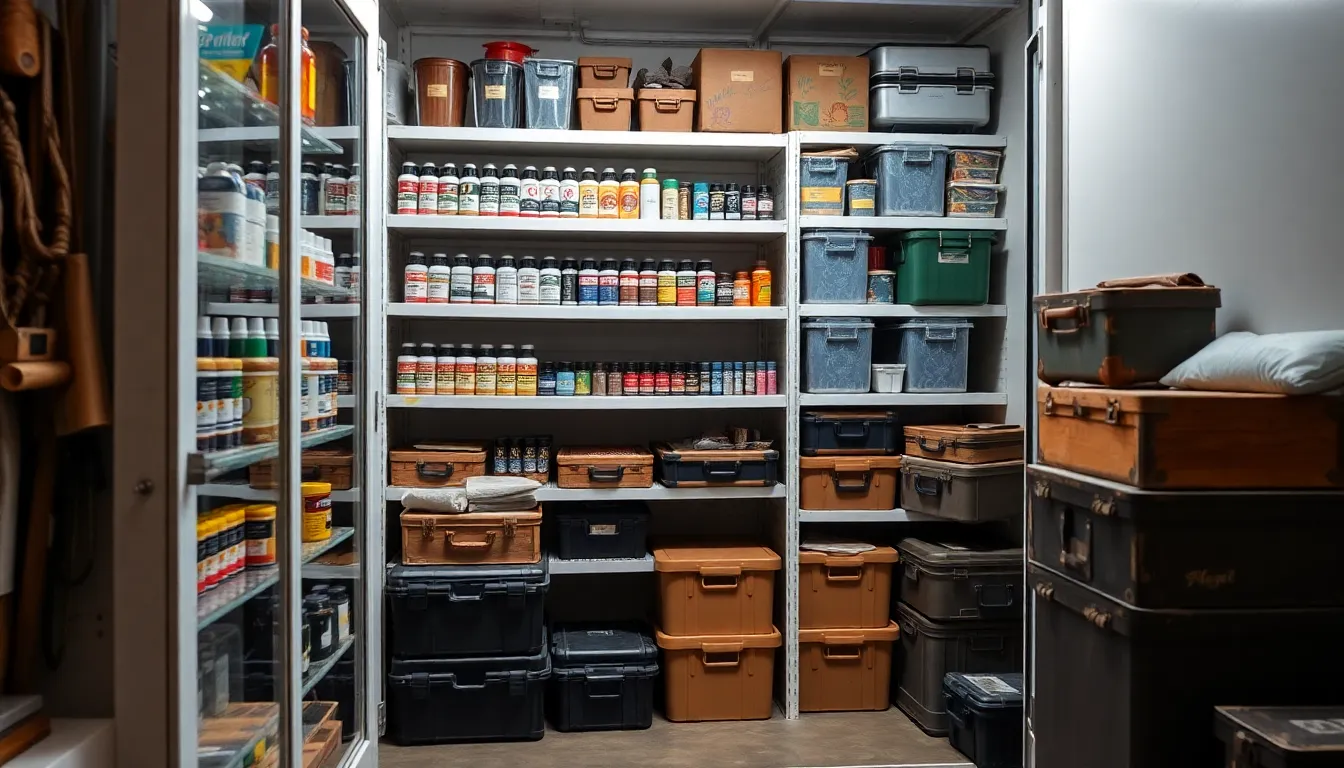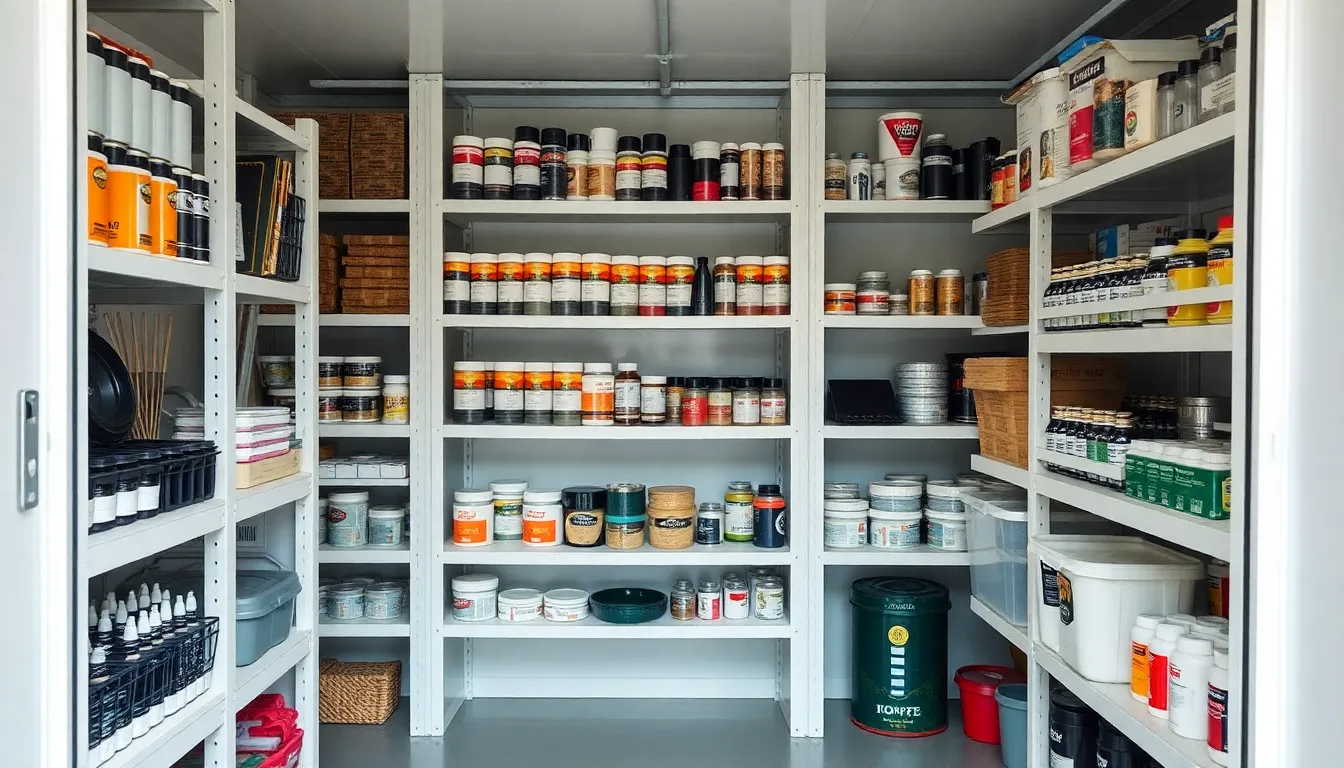Every artist knows the struggle of keeping their precious paints safe and sound. From those vibrant oil tubes to the delicate watercolors, proper painting storage isn’t just a luxury—it’s a necessity. Imagine reaching for that perfect shade only to find it has turned into a sad, dried-up relic of its former self. Yikes!
Table of Contents
ToggleOverview of Painting Storage
Effective storage for paints is crucial to maintain their quality. Proper techniques can significantly extend the life of materials, preventing unnecessary waste.
Importance of Proper Storage
Proper storage preserves the integrity of paints, ensuring longevity. Artists rely on vibrant colors and consistency for their work, making the condition of their materials essential. Temperature control plays a vital role, with most paints requiring cool, dry environments. Containers should remain sealed to avoid exposure to air, which leads to drying. Selecting appropriate storage solutions, such as airtight jars or specialized paint boxes, offers protection against moisture and contaminants. Organized storage systems help artists locate supplies quickly, improving efficiency.
Common Challenges in Storing Paintings
Storing paintings poses numerous challenges, particularly regarding space and environmental factors. Limited studio space can make it difficult to arrange artworks neatly. Environmental factors like humidity and temperature fluctuations threaten the condition of finished pieces. Dust accumulation on surfaces can damage paintings as well. Selecting incorrect materials for storage, such as plastic wrap, may lead to sticking or discoloration over time. Consistent monitoring of storage conditions is essential to safeguard artworks effectively. Adopting efficient practices for both paints and finished works contributes to an artist’s overall success.
Types of Painting Storage Solutions


Various storage solutions exist that can effectively preserve the quality of paints and artworks. Understanding the options helps artists choose the best methods for their needs.
Climate-Controlled Storage
Climate-controlled storage maintains a consistent environment, crucial for preserving paints and artworks. Temperature stability between 65°F and 75°F, alongside humidity levels around 40% to 60%, keeps paints fresh. By using storage units with these conditions, artists prevent drying and cracking in oil and watercolor paints. Some facilities offer specialized units equipped with monitoring systems that alert owners to any environmental changes. Choosing this option is especially beneficial for artists with extensive collections who prioritize the longevity of their materials.
Portable Storage Options
Portable storage options cater to artists on the move. Artists can utilize carrying cases, carts, or boxes that secure paints during transportation. Many portable containers come with built-in organization systems to separate paint types while ensuring easy access. Lightweight designs make them easy to transport between studios, classes, or outdoor locations. Selecting options with durable materials further protects against damage during transit. These solutions offer convenience while maintaining the integrity of the paints and ensuring they remain ready for use.
DIY Painting Storage Tips
Effective storage solutions for paints can significantly enhance their lifespan. Following these tips ensures artists maintain the quality of their materials.
Materials for Safe Storage
Airtight containers work well for various paint types, including oils, acrylics, and watercolors. It’s important to choose glass or heavy-duty plastic options to prevent leaks and contamination. Palette knives serve as excellent tools for scraping excess paint back into containers, reducing waste. Using labels on each container helps track colors and types easily, making organization more straightforward. Additionally, consider investing in climate-controlled storage bags, especially for water-based paints, which are sensitive to temperature changes. These materials contribute immensely to preserving paint integrity and preventing drying or spoilage.
Organizing Your Paintings
Dedicating a space for finished artworks streamlines the organizational process. Use flat storage solutions like archival boxes to keep paintings safe from bending or crumpling. Vertical storage racks provide easy access while preventing damage to delicate surfaces. Group paintings by size or medium, allowing quick retrieval during projects or exhibitions. Additionally, maintaining an inventory of artworks helps track locations and conditions, ensuring artists can locate pieces efficiently. Using protective coverings, such as acid-free sheets, minimizes dust accumulation and safeguards paintings from environmental factors.
Professional Painting Storage Services
Professional painting storage services offer artists secure and optimized environments for preserving their materials and artworks. These facilities ensure that paints and finished pieces remain in excellent condition.
What to Look For in a Storage Facility
When choosing a storage facility, artists should prioritize climate control. Temperature and humidity regulation play crucial roles in maintaining paint quality. Look for facilities with specialized monitoring systems that track these conditions. Security features, such as surveillance cameras and restricted access, are equally important, as they protect valuable artworks. Clean environments minimize the risk of dust accumulation, contributing to long-term preservation. Accessibility also matters; select facilities that allow easy retrieval of materials and artworks as needed.
Cost Considerations
Cost can vary significantly among painting storage facilities. Monthly fees depend on factors like location and available services. Climate-controlled units typically incur higher costs, reflecting their added value in preserving paints and artworks. Budgeting for additional services, such as packing and transportation, might lead to extra charges. Artists should consider insurance options to protect their investment, adding another layer of financial consideration. Assessing various facilities against pricing will help ensure optimal value while still prioritizing quality and security.





